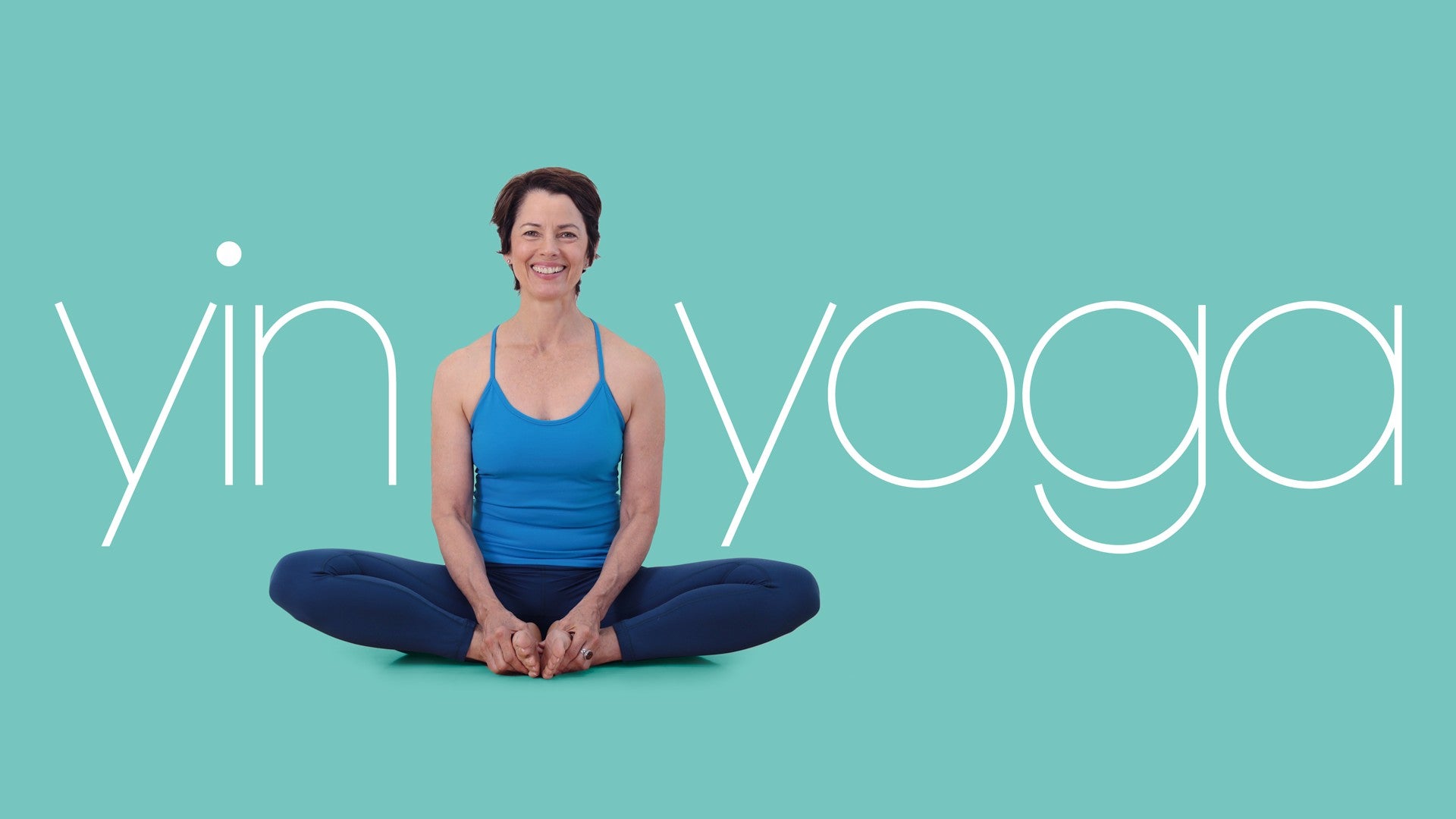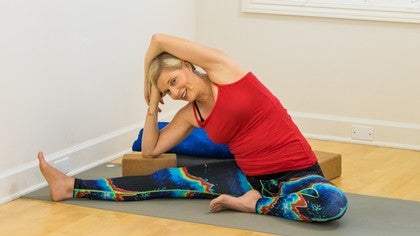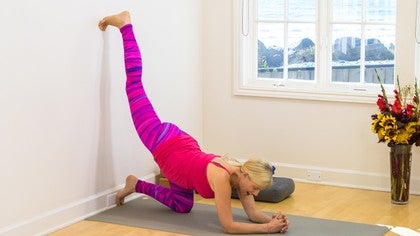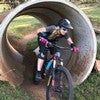Description
Transcript
Read Full Transcript
Hi yogis, I'm so glad you're going to join me today. So we're going to start on the belly in Sphinx pose. This is a really great class for the low back. That's my intention is to help your low back with this class. So I am using bolsters and blocks because I'm pregnant.
So you can come straight onto your belly if you want, but I'm just going to lower my pelvis down and lean into my forearms on the block. So this is Sphinx pose. And if you want to do it this way, certainly you can. I'm doing it with the bolster underneath my pubic bone and I'm going to be here for about two minutes. So just nice, a nice little series that wouldn't take you too long just to work your low back.
So when you're in this pose, a lot of times you would think you'd want to stretch. I think a lot of people who have low back issues think they want to stretch their low back, which we are going to do in this series, but you also want to give it some stimulation with what we're doing now, which is extension of the spine or back bending and we're compressing the low back. So there's a lot of tissue back there that we're just, and this is where all these major muscles anchor is at the low back. It's called the thoracolumbar fascia. And so we're stimulating that area at the back of the pelvis and right about at the low back at the lumbar spine.
So it's almost like you're squeezing it to wake this area up. We're reminding the body that we want it to be able to do this movement and we want this tissue to stay alive. So certainly you could have stayed down on the forearms. I'm lifting up. It feels a little bit, I needed this much stimulation.
This is where I want to be, but I'm not going beyond my edge in any way. You could also drop your chin forward or lift your chin up. But since this is a series for the low back, think about how the movement of your head affects your low back. Pay attention to that. Like me, for me, just keeping my head straight forward really feels like I'm able to just feel the low back the most.
As you're ready, just start to ease yourself down. If you had your arms straightened, you might come down onto the forearms for a moment first. And if you're not using props like me, you might just come all the way onto the belly, bring your elbows wide and rest your head down. I'm going to push back to child's pose. So I'm pushing down into the forearms, walking the knees in a little bit, and I'm just going to push back into a child's pose position.
We're actually going to hold this child's pose for about a minute. So we're taking the spine into the opposite direction. So it's not just like a little rebound. Try to find a child's pose that feels comfortable. And again, we'll be here for about a minute.
So I have my knees wide to accommodate for the baby, but you could have your knees together. Just really let go of the low back. So feel that you're surrendering this area. Our mind can have such an impact on these poses. So use your mind to feel the low back.
Certainly you can just drift away and let your thoughts hopefully be less chaotic if they are. If your mind is going a lot, then focus on the breath or the sensation. We'll just start to ease out. So we were only there about a minute. We're going to come into a squat.
So in my squat, I'm going to use a blanket. You could certainly sit on a block or even use the wall. But I'm going to use a blanket. And the reason why is because my ankles or my heels don't touch the floor completely. So it's much more comfortable for me.
I can do a squat with my heels touching the floor, but this is a much more comfortable for me. So I'm going to prop my heels up on the blanket and I'm not going to lean against the wall, but I'm going to get this close so I could show you. You could just lean against the wall without the blanket underneath you. And this could be your version of a squat. This could be nice.
I feel this more though, personally in the groin and in her thighs, and I'm trying to get into the low back. So I'm going to scoot myself forward a little bit off the wall and just let myself drop down here. So for about two minutes here, a lot of times we see people in this pose in Milasana with their hands in prayer and you know, it's this big, more beautiful looking pose, but it's fine if you just let your head drop down. And again, you certainly don't need to use the blanket. I'm using it simply because it keeps my heels elevated.
These can be wide, toes can turn out. So I'm going to push back up for maybe the second half and just lift up. I like to think of this pose like you think of the bridge of the pelvis, you let the pelvis really sag if you can. So in cultures where chairs maybe are not as ubiquitous, this is a pose that's done more often. So this is a good pose for me because I do sit in a chair and I hope it's a good pose for you.
At any point you can come out to if this is too much. And then I'm just going to start to ease out of it and come right into a dangle. So I'm going to go ahead and just straighten my legs and I'm going to move forward because I don't need to stand on the blanket anymore. I'm going to move the blanket out of my way and come right into a dangle. I do like a block some days and I'm feeling like this is one of those days to lean into in my dangle.
We're going to be here about two minutes. So we just stretch the low back in our squat and now we're stretching the back of the spine again, the whole spine really getting traction on the spine. Let the head hang heavy. Again you want to feel that like almost bowling ball of the head so that it's like a nice weight. The weight of the skull feel the weight of the brain but what's good about the dangle versus the squat is now we're opening up the back of the legs.
So you might even encourage a little bit of a stretch of the back of the thigh, the hamstrings. So if you're not feeling the back of the thigh you might straighten the legs a little bit more, maybe lift the sitz bones a little bit more, maybe even rock a little bit further forward into the front of the foot. You're not overdoing it. We're just trying to get into that hamstring muscle because sometimes tight hamstrings can affect the low back. So great for the backs of the knees where the blood supply goes to the lower leg.
You notice I'm making little movements or I'll tell you I'm making little movements. You're allowed to move in these poses. If you find a place where you need to linger, do that, stay there but you can shift ever so slightly. So instead of rolling the spine up out of this pose we're going to come right into a child's pose. So I'm just going to soften the knees and get the block out of the way and I'm just going to ease myself right into a child's pose.
So this means we've kept the spine in a position of flexion for quite a while. So I'm going to have my knees wide. You can bring yours together if you want. Remember mine's for pregnancy reasons and then I'm just going to prop my head up on my forearms. Just take the child's pose that feels comfortable for you.
We'll be here about a minute. One of the things I really like about child's pose is that it encourages me and I hope it encourages you to breathe into the back of the body, to breathe into the back of the ribs and even the side ribs. So you're not just breathing into the front of the chest. Now last few breaths I'm going to lift up onto my forearms and maybe just kind of look forward a little bit. For me this is a little bit of an arching of the back, feels good.
And then it's almost like I'm taking the slightest little cat and cow here, which may feel good. You might choose to just stay in too. We're going to come up into a half butterfly pose. So half butterfly, I'm going to do the right leg first. I'm going to extend my right leg out and I'm going to bring the left sole of the foot towards the inner thigh.
I'm not going to be specific about it. I actually like my foot a little bit away. So you could do this in more of a Janu Shoshasna way where you've got the foot straight forward, blah, blah, blah. But I'm really looking for a stretch in my left low back and maybe right hamstring. So this is the way that I get that stretch.
And so I want to encourage you, I'm giving you the target area, in other words, the target area is the back of the right thigh and maybe the left low back. So let's start to hope you can find that. So usually what I do is I set myself up in this position and then I just start to walk my hands forward until I start to find that place. And then I'm going to come over to the side. So you could go over to the left and feel something there, but I'm going to come over towards the right and I've set a block up for myself here because I know I like it.
And I'm going to just lean into that block. We're going to be here about two minutes. So I'm going to lean into the block and then I start, I'm going to lift my arm up a little bit eventually. And you could go ahead and come there, but I'm just going to start here, just feeling this stretch in the side body. I just noticed I was really tense in the right foot, so I'm going to let my right foot relax.
And then once I feel like I'm in there and I'm relaxed, I'm feeling a nice stretch here without ever doing it, I'm going to lift my left arm up. And I just bend my left arm and let it rest on my head. So for those of us who've done a good bit of, you know, a shtanga or a yangar or any kind of vinyasa and we've been taught a lot of alignment, yin can be daunting because the poses are not as perfect. They're not as pretty maybe. So don't try to make the pose look pretty.
It's function, not aesthetic. The stretch is in the back of my right thigh and I'm getting a stretch in my left low back. Yay, that's what I want. At this point I've been in there, I think, long enough that I can probably move the block away and just go a little lower. So as I go lower and I get a little deeper, I'm starting to lose it in the back of my right thigh, which is okay.
But I know that if I start to rotate my body and fold over my right leg a little bit, I'm going to feel it again. Now I'm feeling it again in the back of my right thigh and I'm still getting a stretch in my left low back, but it's just different. So I hope you're seeing that you have the freedom to move and tune the pose to your liking. So coming back up, that's a good one to come out of. So I can really feel that I got into the low back.
So I'm going to switch sides. So left leg is going to go out, right leg comes in and remember if you've been a strict yogi and modalities that have been real strict about alignment, you might feel that you have to bring the foot in. Try to be a little looser than that and just let the foot be in a comfortable position. And then I'm going to go ahead and set my block up. You might have it on a lower level or not use it at all.
And then I'm going to just start to walk forward. I just usually come forward first and just kind of test the waters. So if I just go forward, I really feel it in my left inner thigh. You might feel it other places. This might, you might get your left hamstring here.
You might also get it by going over to the right, but I'm going to walk over towards my left. I'm going to bring my left elbow to the block, I'm going to keep my right arm down and we'll be here two minutes. I'm just going to lean over. So I hope you can feel from listening even to my voice, even if you're not watching this that there's not a lot of effort. I'm trying to release the effort of it.
So I'm starting to really feel that nice sensation in my right low back. So I'm going to lift my right arm up. So the muscle we're probably stretching here, I can't guarantee, but if you're getting into that right low back, it's a muscle called the quadratus lumborum. It goes from the bottom of your rib, of your back ribs to your pelvis. So if it's tight, it can tend to hike the hip up.
So see if you can let that right hip really drop down, let the right knee relax. I'm feeling like I could go a little deeper, so I'm going to move the block out of the way. Or I'm not trying to make it look pretty, I'm feeling the pose. I'm judging the pose for the feeling of it and the target area, whether it's productive in my target area, not judging the pose by what it looks like. So I'm going to start to turn my torso like I did on the other side.
I don't always do things symmetrically like this, but this just tends to get it for me. So on this side, I'm really feeling my right low back. I'm not as much feeling my left hamstring, but that's okay because I feel like I'm getting such a good stretch on my right low back that this is nice for me. I'm going to start to ease out, take your time, I'm going to get my block out of my way. Well, I might use it actually in the next pose in a bit.
So I'm going to come up, if you wanted to take a little rest, you could, it'd be easy to just pause here and take a little rest. But I'm going to come into a full saddle, and it takes me a little while to set that up. So I'm going to go ahead and start moving into it. So a full saddle, this is a nice back bend. So I'm going to bring the bolster long ways on behind my mat.
So it's going to be behind my pelvis, long ways on the mat. And I'm sitting in between my thighs. So if, in between my feet, if you have tightness in the knees, what you could do is just bring the block underneath and sit on the block. What you'd probably need though at this point, as you can see, is I would probably want another bolster. So I'd want to stack maybe two or three bolsters to do that.
I'm not going to use the block. It doesn't matter how wide your knees are. If you've been, if you've taken classes where the alignment is pretty strict, they might, they might say knees together. I'm not saying that. I'm telling you, you can, if you want to have your knees together, you can.
If you don't, you don't have to. So the goal is for me to get a good back bend here and also to stretch the front of the thigh. So I'm going to start to lean back. And by the way, if the tops of the feet are bothering you, you certainly could put a blanket underneath the feet, but I'm going to lean back. I'm taking my time and you don't have to lean back.
I have, you know, I've had days where I just stay up and just kind of lean back into my hands, but we'll be here about three minutes. So once I get back, first thing I want to check in with is the knees. You don't want to feel this pose in the inside of the knee. You'd rather feel it. If you're going to feel the knee, feeling it at the front of the knee might be okay because the tendons of the quadricep wrap around the front of the knee.
So you might just be feeling kind of a quadricep stretch down into a tendinous stretch. A lot of times I can shift my knees, shift my thigh bones a little bit and feel like I can take pressure off the knees. But as I'm in this pose, I can actually feel, I can feel the blood pulsing. You certainly could bring your arms overhead if you want. I'm going to choose not to today.
I'm going to just rest my hands on my ribs. So stretching the front of the thigh and then maybe for some getting a nice low back compression like a back bend. But like I said, I can actually feel the pulse and I don't think that's just a pregnant thing. I can feel the pulse in my thighs. I can feel the pulse in my pelvis.
I can feel the pulse up into my torso. So it's like the blood is being moved or pushed in a good way. It's circulating is what it feels like to me. And let me clarify that I'm not, I'm comfortable, but there is a level of discomfort. Not pain.
I'm not beyond my edge, but it's work. I'm doing work, if that makes sense. So I think sometimes we get afraid of sensation. But as you do yin yoga more, you start to crave the deeper sensations. Like I'm loving the subtlety of feeling my blood flow.
You might just take one more deep breath into the belly and into the front ribs and then just start to ease out. Not really a pretty way to come out of this pose. So I've heard people say to use your abdominal muscles. I don't. I just use my arms, I use my abs a little bit, but certainly being pregnant, it's a little harder.
I'm just going to ease up, I'm going to boost my hips up and I'm just being really gentle with my knees. I'm not moving fast, I'm going to slowly extend my legs out. Sometimes I get a little popping when I bring my knees out. And what I'm going to do is just lie back onto the bolster. You could move the bolster out of the way or if you don't have one you don't need one, but I'm just going to lie back for a moment with my legs out straight.
And yin we call this a rebound. It's like a little mini shavasana in the middle of in between poses. It's a chance to feel the effects of the pose. So certainly pause it and stay here longer if you want, because sometimes that can be so nice. It's luxurious to get into this state of stillness, so if you're there, stay there.
I'm going to ease myself up though and I'm going to move the props out of the way and we're going to finish with a twist each side. So I'm going to come back down onto my back. I'm going to start with the right leg, so I'm going to bring my right leg over. You don't have to do that, you could just drop your knees over to the left. That's absolutely fine.
I'm going to move these a little bit out of the way. I'm going to scooch my hips over to the right side of the mat and then I'm going to cross my right leg over like I'm sitting cross-legged and drop my knees over to the left. So one of the things I often feel is that a twist can be a little too deep and that's not just because I'm pregnant again, that's more just in general, I think we tend to kind of crank ourselves into twists. So I'm fixing this block underneath my right knee. We're going to be here two minutes.
I'm adjusting this block underneath my right knee to prop up my thigh and the reason I'm doing that is because if I let my knee drop all the way to the floor, I would really be feeling the stretch in the outer hip. I'm not trying to stretch the outer hip here. This is a pose for the spine. This pose is total homage to the spine. Adjust your hands as it feels comfortable.
Don't feel like you have to have your hands out to the side in a T. My right arm is up like in a cactus arm. My left hand is just resting on my rib cage. I'm not turning my head in any specific direction. I would encourage you to turn your head until you find that place that feels like it's good for you. What I'm actually feeling here is the spine.
Because the stretch of the outer hip has been lessened by my knee being propped up, I'm able to feel the more subtle twist of the spinal column. You might notice that your breath is not necessary. I'm starting to ease myself out of the pose by the way, so we'll start to come out. Sometimes with a twist, your breath can actually become subtle. Just unraveling the legs, shift yourself back to a neutral position.
Whether you want to keep the knees bent or not is up to you, but maybe just neutral position. I'm choosing to extend my legs out. Back into a neutral spine and I'm settling the bones, meaning I'm using my mind to tell the body to relax again. Then we'll take it onto the other side. Getting the knees back in.
All you're trying to do in a twist, and this is so worth hearing every time you do a twist, so I'm shifting my pelvis over to the left. All you're trying to do is move the ribs and the pelvis in opposite directions. It's pretty basic. So I'm crossing my left leg over my right, I've scootched my pelvis over to the left, and then I'm going to start to roll onto my right side. I'm going to use the block underneath my left knee on the lowest level on this side, and then about two minutes here.
Very different twist for me, and maybe it's different for you as well, maybe not, but my left shoulder is lifted off the mat. That doesn't bother me. If you want to prop the left shoulder up, you could. You could put a blanket underneath it or a block. But as long as nothing's straining, as long as you're not feeling a pinching, you should be okay.
But I will say on this side, I don't lift the left arm up sometimes. It feels better to just keep the left arm down. So again, I don't want the stretch in the outer hip or the stretch in the chest or down the arm. That's not what I'm looking for personally in this pose. My target area is the spine.
So I'm propping up the legs, and I'm adjusting the arms until I feel like none of the other body parts are screaming at me. In other words, they're not distracting in their sensation. And I'm really feeling the stimulation of the spine. You might start to notice as I am that the spine, as you become more still and more calm, the spine has a life of its own. It's really beautiful.
It starts to just unravel. It has this like slithering sensation is how I would describe it, like a snake. No need to crank yourself in. You just settle for maybe one more breath, and then just ease yourself back out, unraveling the legs. I'm going to scooch my hips back to the center of the mat.
If you moved your pelvis, you can do that, and then just extend the legs out. I'm just resting my hands on my belly or my ribs somewhere in between the abdomen, and I'll just take a little rest on the back. So hopefully the practice made you feel a sense of stillness, and there's not really a desire to move, which is really nice. But if you still feel some fidgety energy, try to pull all that energy back into the spine. Imagine that you're withdrawing into the spine.
As you're ready, maybe just start to bend your knees, bring the soles of the feet to the mat if that feels okay, or you might just roll directly to your side. I'm going to roll over to my right, and get the block out of my way, and I'm just going to push up to seated. So taking the time, being really gentle with the body at this point. Maybe if it feels okay, come to a seated position. Just closing the eyes, and settling the body again.
Thank you so much, Yogis.
Yin Yoga: Kate Smith
Comments
Kate
Perfect word.
I also love the word YIELDING. I can always feel my tissues yielding when I practice Yin...and I know as my tissues yield that the tension is leaving the body. Amen to that
You need to be a subscriber to post a comment.
Please Log In or Create an Account to start your free trial.


















